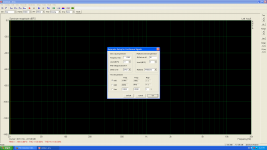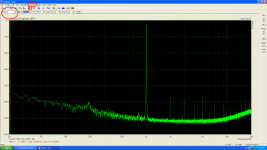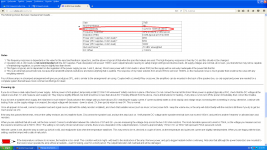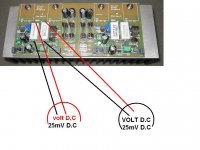@ Ian Finch
first of all thanks a lot
1- one resistor is measuring 50mV and the other is measuring 30mV.
2-actually i don't have any means for measuring output power it's just the feeling of the sound loudness in ref to other amps had listened to.
..yes that's correct some times while measuring power rails during amp is running it's 39V or 40v
Regards
first of all thanks a lot
1- one resistor is measuring 50mV and the other is measuring 30mV.
2-actually i don't have any means for measuring output power it's just the feeling of the sound loudness in ref to other amps had listened to.
..yes that's correct some times while measuring power rails during amp is running it's 39V or 40v
Regards
@ AndrewT
thanks Andrew
i'm not used to match emitter resistance i didn't know that earlier but i'll do as you said... but what a bout the drivers ... this can't be also due to the drivers? i don't know a way to match drivers except measuring each one Hfe with Hfe meter
Regards
thanks Andrew
i'm not used to match emitter resistance i didn't know that earlier but i'll do as you said... but what a bout the drivers ... this can't be also due to the drivers? i don't know a way to match drivers except measuring each one Hfe with Hfe meter
Regards
Short the input ,leave the output empty(nothing connected)
measure output using a voltmeter at d.c scale. What is your measurement?
measure output using a voltmeter at d.c scale. What is your measurement?
also Rod recommends total bias of 75mA (50mV from collector to collector). whats the rms voltage of input source? i think it should be 1.22v for full power.
the drivers do not affect the bias current passing from top to bottom through the outputs.... but what a bout the drivers ... this can't be also due to the drivers? i don't know a way to match drivers except measuring each one Hfe with Hfe meter ............
The drivers do affect the base voltages and this affects the output offset.
It is the DIFFERENCE between the bases that changes the output bias current and that is controlled by the bias voltage coming from the Vbe multiplier.
The difference in subjective loudness compared with other amps is due to gain used in P3A, which is 23 times (27dBs). You can increase the gain if you need higher gain. By doing so the amp will be more stable too.
@ Ian Finch
first of all thanks a lot
1- one resistor is measuring 50mV and the other is measuring 30mV.
2-actually i don't have any means for measuring output power it's just the feeling of the sound loudness in ref to other amps had listened to.
..yes that's correct some times while measuring power rails during amp is running it's 39V or 40v
Regards
Hi Vin Diesel,
Are you sure you've got zero DC at the output?
Cheers,
Valery
@thimios :
the output voltage when shorted the input was about 5mv idon't know if accurate or not i use multimeter Sanwa CD800A.
@prasi :
yes prasi i adjusted the bias current for 50mV ... and my input source is the PC jack i measured the AC of input signal without connecting to amp was 0.4VAC with mutlimeter i think it's peak) and measured with the amp connected is 0.2VAC.
is this normal? i think it's good reason for not full power
@AndrewT :
Good to know that Andrew...my offset is 12mV
@ivanlukic
how the gain can be increased?
the output voltage when shorted the input was about 5mv idon't know if accurate or not i use multimeter Sanwa CD800A.
@prasi :
yes prasi i adjusted the bias current for 50mV ... and my input source is the PC jack i measured the AC of input signal without connecting to amp was 0.4VAC with mutlimeter i think it's peak) and measured with the amp connected is 0.2VAC.
is this normal? i think it's good reason for not full power
@AndrewT :
Good to know that Andrew...my offset is 12mV
@ivanlukic
how the gain can be increased?
12mV d.c offset is ok(5mV when input shorted is even better).
In order to measure A.C signal voltage from your P.C you must instal a software like ARTA and turn on the software generator at 400Hz or 1000Hz.Then a voltmeter(a.c scale) connected in sound card line out indicate the A.C voltage.
Adjust the volume to max in the sound card mixer
You can't measure the output A.C voltage just playing music.
In order to measure A.C signal voltage from your P.C you must instal a software like ARTA and turn on the software generator at 400Hz or 1000Hz.Then a voltmeter(a.c scale) connected in sound card line out indicate the A.C voltage.
Adjust the volume to max in the sound card mixer
You can't measure the output A.C voltage just playing music.
Attachments
Last edited:
i will just download the software and do that measure but while doing that why it can't be done by just measuring the AC signal from PC?
Have you adjust the volume for max.level?thimios
i download it and did the measure the AC signal was 0.76 vAC
1.2V A.C is necessary for full driving (according to Elliot guides).
Look at second picture how you must adjust the bias.
Attachments
Last edited:
yes i did and by searching i noticed this is normal for consumer line level where the professional line level is 1.22v this according to wikipedia
https://en.wikipedia.org/wiki/Line_level
i did that except for that i adjust it to 30mV Elliot said it's not critical but just for reducing the heat of the power transistors but i think that has nothing to do with the input signal
can't i decrease the input resistance or connect some kind of buffer , preamp or live level buffer for that issue ?
now i know the problem is ot with the amplifier it's with in my signal source i may just simply use higher power amplifier but i need to figure something out to solve this issue to get use of the unused power

https://en.wikipedia.org/wiki/Line_level
i did that except for that i adjust it to 30mV Elliot said it's not critical but just for reducing the heat of the power transistors but i think that has nothing to do with the input signal
can't i decrease the input resistance or connect some kind of buffer , preamp or live level buffer for that issue ?
now i know the problem is ot with the amplifier it's with in my signal source i may just simply use higher power amplifier but i need to figure something out to solve this issue to get use of the unused power

Last edited:
No input signal and bias adjustment are two different things.yes i did and by searching i noticed this is normal for consumer line level where the professional line level is 1.22v this according to wikipedia
https://en.wikipedia.org/wiki/Line_level
i did that except for that i adjust it to 30mV Elliot said it's not critical but just for reducing the heat of the power transistors but i think that has nothing to do with the input signal
can't i decrease the input resistance or connect some kind of buffer , preamp or live level buffer for that issue ?
now i know the problem is ot with the amplifier it's with in my signal source i may just simply use higher power amplifier but i need to figure something out to solve this issue to get use of the unused power
View attachment 590906
I post the bias adjustment just to be shure that you anderstund the prosedure well.🙂
thanks thimios
i think at this issue they use a phono preamp such that of elliot P06 what you think i never used preamp i just did 3-way crossover sometime a go
i think at this issue they use a phono preamp such that of elliot P06 what you think i never used preamp i just did 3-way crossover sometime a go
that's a good idea i will do that ... what is the minimum resistance value for R4 and is there limitations on this value?
I'm planning to build a P3A and the problem is the transistor choice.
I have a many old transistors that I can match or I can buy new ones that will not be matched. What is the better option?
Old ones are like 2N3055+BDX18 and tip29/30. Recently bought few bd139/140 also.
I'm thinkin of building it as a quasi complementary. Or I should avoid it and stay with sziklai configuration?
I have a many old transistors that I can match or I can buy new ones that will not be matched. What is the better option?
Old ones are like 2N3055+BDX18 and tip29/30. Recently bought few bd139/140 also.
I'm thinkin of building it as a quasi complementary. Or I should avoid it and stay with sziklai configuration?
- Home
- Amplifiers
- Solid State
- P3A Comparison table ( long .... )



